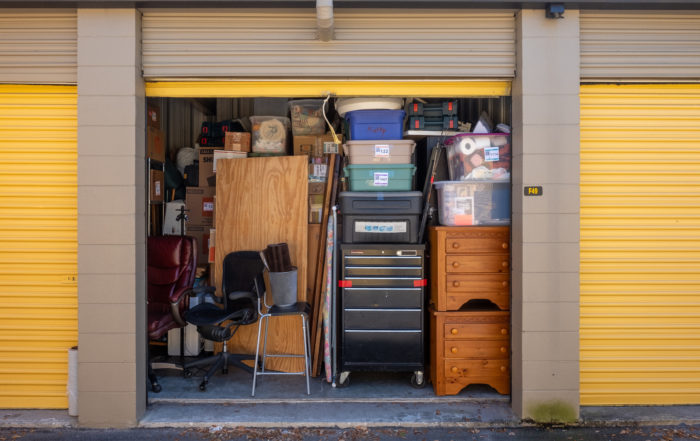Tips on Driving a Moving Truck in Icy Conditions

It’s getting to be that time of the year again — the time of ice and snow. At Albuquerque Self Storage, we want you to get to your destination safely. So if you’re planning on moving or driving a larger truck to move furniture, these tips are for you.
Before You Start Driving
There are a few things you should check before you even get behind the wheel. There are the obvious things, like checking the weather for the entire trip so you don’t hit any unexpected storms, or you can avoid them entirely. While driving, listen to the radio to stay up to date with the weather too.
Before you finish packing, make sure you have an ice scraper and a snowbrush in an easily accessible spot. If you have room, stock up on basic supplies too, like a blanket, extra clothes, flashlight, food, and bottled water. Sunglasses are essential too in case the glare off the snow is too much.
All of those are essential because the larger truck you’re driving, the easier it is to lose traction and control if you hit ice. You never know if you’re going to need to wait for assistance, so you will need to be prepared.
If you’re travelling through mountain passes or northern states, have tire chains available. Some states require these. Tire chains are not provided with truck rentals.
Truck Driving on Ice
Driving your moving truck through winter conditions is not always avoidable. You already know that you want to go slow and steady the entire time you’re driving the moving truck. You’re going to want to prepare yourself for any mishaps, including skids.
Leave Extra Space
Just remember that snow and ice don’t just affect you—they affect all of the drivers on the road. Ever been stuck behind a larger car in a rainstorm? The same thing happens to other cars near you — your truck will kick up slush, ice, and debris. Always leave as much room as you can between other cars and drive as defensively as possible for your safety and theirs.
Driving a moving truck isn’t that much different than driving a car. It does feel different, especially at first, but you will get used to it over time. The key thing to remember is that you will need to leave more space to give yourself time to react.
Trucks are larger than cars, therefore they take longer to slow down/stop and take wide turns. In icy conditions, this means it’s imperative you take your time. Don’t tailgate, don’t take turns quickly, and don’t expect larger trucks
Always fill the gas tank before you hit the halfway line. Less gas in the tank can lead to water condensation in the fuel line. This can cause internal damage to your engine, including rust!
Go Slow On Bridges
If you’re crossing a bridge or an overpass, slow down. They ice over pretty quickly, even if they’re salted. It also gets pretty windy on bridges and overpasses, as well as in flat areas, so be aware of any wind warnings. Larger trucks are prone to tipping even on sunny summer days, so just be cautious! It’s better to be late than to risk it with wind, especially when ice is involved.
Once you hit the regular ground again, be sure to use caution when speeding up. There could be run off at the base of the road and bridge.
Always Care about Visibility
You’re higher up in a truck, which means it’s easier for you to see out your windshield, but it can be harder to see the cars below you due to kicked up snow and mist.
You should always have complete visibility out your windshield, even if outdoor conditions are making it hard to see. If ice or steam cover up any part of your windshield, pull over and take care of the issue before proceeding.
Even if it’s day, keep your lights on. You will want to ensure you can see other cars and other cars can see you, no matter what.
Keep Your Gas Tank Full
Always fill the gas tank before you hit the halfway line. Less gas in the tank can lead to water condensation in the fuel line. This can cause internal damage to your engine, including rust!
Keeping a full tank of gas also adds additional weight to the truck, which can make a lot of difference in winter conditions!
Pump Your Brakes
If it’s slippery out, pump your brakes — do not slam on them! If you can, avoid hitting your brakes hard all together to help avoid skids on slippery roads.
If you feel yourself slipping on the road, start lightly pumping on the brakes. This will slow your truck down faster than letting it idle and won’t cause a sudden stop, which will make the slide worse. Pumping your brakes will give you more traction and will give you time to help you reverse any uncontrolled movements.
If you’re truly concerned about driving your moving truck in unfavorable winter conditions, pass the job off on to somebody else. Professional movers have experience driving in all types of weather and moving locations (even a storage unit!), and the extra cost to hire them for your cross country move is worth your safety and your sanity.
Recent Posts
Understanding Self-Storage Lease Terms: What to Know Before You Sign
Renting a self-storage unit is often one of those tasks that feels simple at first—pick a unit, sign a lease, move your stuff in. But if you’re like most people, the fine print on that [...]
What Not to Do When Using a Self-Storage Unit: 9 Common Mistakes to Avoid
Self-storage units are a convenient and affordable way to store everything from furniture and keepsakes to business inventory and seasonal gear. Whether you’re moving, downsizing, or just trying to declutter your space, renting a storage [...]
How to Keep a Storage Unit Clean and Tidy
A self-storage unit can be a lifesaver when you need extra space, but without proper organization and upkeep, it can quickly become cluttered. A clean and tidy storage unit not only makes it easier to [...]



